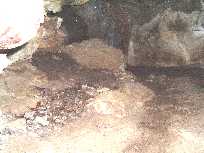Caving
Caving Tips : Caves by State : Photo Galleries

Whether you're a spelunker or a seasoned caver nothing is more important than safety as you crawl, climb and drop through what at times can appear to be the belly of some kind of prehistoric dinosaur fossil known as a cave. Always tell someone where you are going and what time you predict you'll be back from your cave adventure. Bring at least 2 fellow cavers, make sure you are well hydrated before you go and make sure one of the cavers with you is very experienced. (Cell Phones don't work in caves so leave it behind with your sunglasses.)
Wear a helmet (brain bucket), bring multiple sources of light, fresh batteries, light bulbs and water and solid foods such as nuts.
Some cavers believe that the LED lights are good only to maintain night vision and prefer actual halogen head lights and halogen flash lights to the new trend in LED lights. There is a difference. The halogen headlights with standard light bulbs do give the caver better vision and unaltered views of the next hold or crevasse, while the LED headlamps provide a kind of hazy view although steps are being taken to correct this. Unless your up close, standard LED lights don't provide good enough light through the holes to plan your crawl, decent or climb. LED batteries do last longer so carry one as a backup source of light especially on long cave adventures. If you spent the 30 dollars for an LED and feel the need to buy a standard light bulb headlamp, the LED head lamps do make great reading lights inside the tent after a long day of caving. Some people who are serious about caving spend the extra on a duo head lamp which has both halogen and L.E.D. capabilities, which allow the caver to switch between halogen and L.E.D. when necessary. The Halogen does draw a lot of energy from the battery pack so bring an extra set or two of fresh batteries.

Knee pads are a must as well as thin multiple layers of clothing. Be sure one layer is made of some type of insulating fabric like wool, stay away from synthetic clothing, it tends to get rank after a while. Make sure your clothing lacks anything that could snag or get hung up on cave features. Bring some nylon rope and a durable waterproof pack to carry extra supplies batteries etc...water and solid foods like nuts. The rope can be used to aid in climbing or to lower your waterproof pack down crevasses allowing you to maintain at all times at least three points touching at all times down cracks. It is very uncomfortable in tight spots like the meat grinder and sometimes dangerous to have your pockets loaded with gear.
Do not wear any jewelry. Looking beautiful for the bats and other cave dwelling creatures isn't worth the loss of a finger. Speaking of cave critters. Keep in mind that some critters like bats require cool temperatures in order to thrive. Every time you enter their areas you bring your body temperature which can raise the temperature of the "bat rooms". Don't spend time shining the bats with your lamps that too can raise the temperature or can awaken a hibernating bat and cause the bat to loose necessary stored energy to survive hibernation. It's best not to cave crawl a known bat area.
When deciding whether or not to negotiate a tight space first have the "thickest" or broadest person go first. If that person is an en experienced caver they should know when and if they need to slide back. Remember even the most experienced guides have had to dig themselves out at times when they have gotten stuck. That's how some openings grow wider and taller. If you or someone with you gets stuck, don't panic relax and talk reassuringly until help can be arranged if necessary.
Freezing water is a whole other issue to contend with when deep inside a cave. Be prepared and try to enter and leave water as quickly as possible. If you are with a large group walk through in groups of two. This is important just in case someone needs to take extra time negotiating "low air" (when there is little air space between the water level and the ceiling also known as an earclip) spaces, the others can wait on dry areas before venturing into the water.
Be sure to look back at the crack, hole opening you just crawled through. Study the features, and give it a name like toilet bowl, meatgrinder, Bill's crack, to help you remember when the time comes to leave the cave.Plan your cave adventure carefully and be prepared for hypothermic conditions. Understand that many caves are in a sense living and conditions can change quickly. Some caves are very wet with underground rivers. If while caving you notice changes in the water levels, get out or find high ground. That could be a sign that rain or a storm system is somewhere maybe far away feeding the stream.
Don't leave anything in the cave you brought in, and leave what you find in. If you bring a camera remember in the cold temperatures the lens will condense unless brought down to the temperature of the cave. Cameras should be kept in a hard shelled water proof container with good padding.

